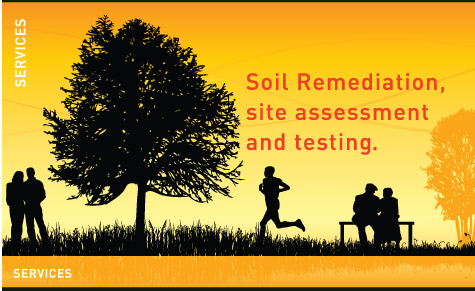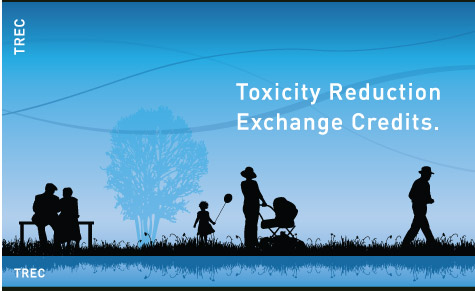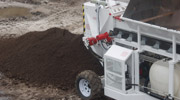

A B C D E F G H I J K L M N O P Q R S T U V W X Y Z
A
Absorption
Uptake of matter or energy by a substance.
Acid soil
Soil with a pH value less than 7.0.
Acidification
Process whereby soil becomes acid (pH < 7) because acid parent material is present or in regions with high rainfall, where soil leaching occurs. Acidification can be accelerated by human activities (use of fertilisers, deposition of industrial and vehicular pollutants).
Adsorption
Process by which atoms, molecules or ions are retained on the surfaces of solids by chemical or physical bonding.
Aeration of soil
Amount of air-filled pores in the soil, expressed as the volume difference between total porosity and actual soil moisture. Optimum soil aeration is 30% but strongly depends on the structure and packing state of soil particles; 15-20% is normally satisfactory for the growth of grasses and cereals; below 10% is not good for plant growth.
Aerobe
An organism that can grow in the presence of air.
Anaerobe
An organism that can grow in the absence of oxygen or air.
Aggregate
Soil aggregate consisting of two or more soil particles bound together by various forces.
Aggregation
Process whereby primary soil particles (sand, silt, clay) are bound together, usually by natural forces and substances derived from root exudates and microbial activity. Soil aggregates are arranged to form soil peds, units of soil structure, classified by size, shape (platy, prismatic, columnar, angular, subangular, blocky, granular…) and grade (single-grain, massive, weak, moderate, strong). From an agronomical point of view, the most important soil aggregates are in range 3 - 1 mm.
Anaerobic respiration
Use of inorganic electron acceptors, other than oxygen, as terminal electron acceptors for energy yielding oxidative metabolism. Examples include nitrate respiration.
Anion
Particle with a negative charge. See also ion, cation.
Anion exchange capacity:
Sum of exchangeable anions that a soil can adsorb. Usually expressed as centimoles, or millimoles, of charge per kilogram of soil (or of other adsorbing material such as clay).
Asbestos
The fibrous varieties of a number of silicate materials used as fabrics for heat and electrical insulation and fire-proof fabrics, as a binder in asbestos cement building materials, and in filtration. Inhalation of certain asbestos fibres can cause asbestosis, a lung disease, which is frequently fatal.
Assessment endpoint
Explicit expressions of the environmental value that is to be protected. Assessment endpoints should be defined in terms of the valued ecological entity (species, ecological resource or habitat type) and a characteristic of the entity to protect, e.g. reproductive success.
Attenuation
Reduction in contaminant concentration, availability or toxicity through biological, chemical and physical processes.
B
Bioaccessibility / Bioavailability
Bioaccessibility is the fraction of a substance that is available for absorption by an organism.
Bioavailability is the fraction of a substance that can be absorbed by the body through the gastrointestinal system, the pulmonary system and the skin. By its definition, bioavailability also includes the process of bioaccessibility.
Bioaccumulation
Accumulation of environmental contaminant, such as heavy metals, within the cells of living organisms.
Bioassay
Biological tests using specific organisms to quantify the toxicity of contaminated soil and water samples.
Bioaugmentation
Addition of specifically prepared cultures of organisms to carry out specific functions such as biodegradation, in the environment.
Biodegradation
Decomposition of a compound into smaller chemical sub units through the action of organisms, typically micro-organisms (bacteria, fungi and actinomycetes).
Bioindicators
Multiple measures of organism health to environmental stressors, which include several levels of biological organisation and timescales of response. Because organisms are subjected to a variety of stressors in their environment, multiple measures of health are needed to help identify and separate the effects of man-induced stressors (such as contaminants) from the effects of natural stressors (such as food and habitat availability.
Biological contamination
Contamination of soil or groundwater with bacteria, viruses and fungi as opposed to chemical or radiological contamination.
Bioremediation
The elimination, attenuation or transformation of polluting or contaminating substances by the use of biological processes, to minimise the risk to human health and the environment.
Biological remediation techniques
Remedial techniques that rely on processes carried out by living organisms or occurring due to the activity of organisms, such as degradation, transformation, sorption, accumulation or solubilisation. Established biological remediation methods include landfarming, biopiling, biosparging and bioventing.
Biosensor
Analytical device containing a biological material that acts as a sensing element. When exposed to a contaminant, the sensing element generates an information-linked response, which can be obtained via a suitable transducer.
Bioslurping
Simultaneous withdrawal of non-aqueous phase liquid (NAPL), groundwater and/or soil gas from the groundwater layer using a single pump.
Biosparging
Injecting a gas (usually air) under pressure intro the saturated zone to provide oxygen (or an alternate electron acceptor) to facilitate microbial degradation of contaminants in groundwater and saturated soil.
Biostimulation
Addition of nutrients, oxygen and/or water to stimulate micro-organisms in contaminated soils, to enhance biological processes.
Biotransformation
Conversion of a contaminant to a less toxic and/or less mobile form.
Bioventing
The process of supplying oxygen in situ to oxygen deprived soil micro-organisms by forcing air through unsaturated contaminated soil at low flow rates. This stimulates biodegradation and minimises stripping volatiles into the atmosphere.
Brownfield sites
Any land that has been previously developed or requires work to be carried out to it to bring it into use.
Building structures and services
Aspects that could be affected by contamination including concrete and metal structures such as foundations and underground services such as plastic potable water pipes.
C
Capillary water
Water in capillary pores influenced by forces that hold water in soils against a tension usually greater than 60cm. Capillary water can move upwards against gravity.
Capping / containment / cover systems
Engineering based remedial techniques used to block contamination pathways through horizontal or vertical containment of sources.
Carbon cycle
Sequence of transformations whereby carbon dioxide is converted to organic forms by photosynthesis or chemosynthesis, recycled through the biosphere (with partial incorporation into sediments), and ultimately returned to its original state through respiration or combustion.
Cation
Particle with positive charge; reactions between anions and cations create electrical forces.
Cation exchange
Interchange between a cation in solution and another cation in the boundary layer between the solution and surface of negatively charged material such as clay or organic matter.
Chemical analysis
Laboratory analysis of soil and water samples to determine concentrations of contaminants present.
Chemical contamination
Contamination of soil or groundwater with chemical contaminants, including inorganic and organic substances, as opposed to biological or radiological contamination.
Chemical remediation techniques
Remedial techniques that breakdown or stabilise toxic compounds by using one or more types of chemical reaction.
Chlorinated solvents
Chlorinated hydrocarbons used in applications such as metal degreasing and dry-cleaning.
Chronic effect
An adverse effect on a human or animal in which symptoms recur frequently or develop slowly over a long period.
Clay
Soil particle smaller than 0.002mm or 2µm, with high specific area mainly influencing soil colloidal properties (see also colloid) as well as stability of soil structure: high stability in both wet and dry conditions; also a soil texture class.
Clay coating / film
Coatings of oriented clay on the surfaces of peds and mineral grains and lining pores, also called clay skins, clay flows, illuviation cutans, or argillans.
Clay loam
Soil texture class. See also soil texture.
Clay minerals
Clay-sized hydrous aluminium silicates having a large interlayer space that can hold significant amounts of water and other substances; they have large a surface area allowing swelling and shrinking; examples are montmorillonite or smectite and kaolinite.
Colloid
Particle, which may be a molecular aggregate, with a diameter of 0.1 to 0.001µm; clay and soil organic matter are often called soil colloids because they have particle sizes that are within, or approach, colloidal dimensions.
Colluvial
Pertaining to material or processes associated with transportation and/or deposition by mass movement (direct gravitational action) and local, unconcentrated runoff on slopes and/or at the base of slopes.
Colluvium
Unconsolidated, unsorted colluvial material.
Combustible materials
Materials present in the ground capable of igniting and burning easily, such as coal residues, with a high calorific value.
Co-metabolism
A process in which a compound is fortuitously degraded by an enzyme or co-factor produced during microbial metabolism of another compound.
Conceptual model
A textual or graphical representation of the relationship(s) between contaminant source(s), pathway(s) and receptor(s) developed on the basis of hazard identification, and refined during subsequent phases of assessment.
Contaminant
See Source.
Contaminated land
Any land that appears to the local authority in whose area it is situated to be of in such a condition, by reason of substances in, on or under the land, that:
a) Significant harm is being caused, or there is a significant possibility of such harm being caused or
b) Pollution of controlled waters is being, or is likely to be, caused (EPA 1990; Section 78[2]).
Contaminated site
Any site that, as a result of activities either previously or currently carried out on it, contains concentrations of substances or pathogens high enough to be a hazard to health or the environment either in the current use of the site or if it is used for a different purpose (Royal Commission on Environmental Pollution, 1996, Sustainable use of soil, 19th report).
Controlled waters
All fresh and saline natural waters up to the UK offshore territorial limit, including rivers, streams, lochs, estuaries, coastal waters and groundwater. The statutory definition of controlled waters is given in the Water Resources Act 1991, s 104(1) and the Control of Pollution Act 1974, s 30A(d).
D
Decalcification
Removal of calcium carbonate or calcium ions from the soil by leaching.
Diagnostic horizon
See horizon.
Derelict land
Land so damaged by industrial or other development that it is incapable of beneficial use without treatment.
Desk study
Interpretation of historical, archival and current information to establish where previous activities of the land were located, and where areas or zones containing distinct and different types of soil contamination can be expected to occur, and to understand the environmental setting of the site in terms of pathways and receptors.
Detailed investigation
Main on-site investigation involving sampling and analysis to characterise ground conditions for a specified purpose; may be undertaken as a single stage or as several successive stages.
Discharge consent
Authorisation issues by the regulatory authorities (Environment Agency, Scottish Environment Protection Agency, Environment and Heritage Service Northern Ireland) permitting discharge or effluent into controlled waters to prevent pollution.
E
Ecological risk assessment
Qualitative and/or quantitative analysis of the actual or potential effects of contamination on ecological receptors other than humans and domesticated species.
Ecosystem
A living entity of populations co-existing as a unit, with the capacity to interact with one another and their physical and chemical environments.
Ecotoxicity
Aspects relating to substances which are dangerous to the environment, being toxic or harmful to organisms or with the potential to cause long term effects in the environment.
Ecotoxicology
The study of the toxic effects of agents on living organisms.
Effect endpoint
Measurable biological response to a stressor that can be related qualitatively or quantitatively to the characteristic chosen as the assessment endpoint.
Electron acceptor
Compound that is reduced in a metabolic redox reaction.
Electrical conductivity (EC)
Conduction of electricity through water or a solution of soil commonly used to estimate the soluble salt content in solution, e.g. soil solution.
Endpoint
See assessment or effect endpoints.
Erosion
The wearing away of the land surface by water, wind, ice, gravity or other natural or anthropogenic agents that abrade, detach and remove soil particles or rock material from one point on the earth's surface, for deposition elsewhere, including gravitational creep and so-called tillage erosion.
Exploratory investigation
Preliminary limited intrusive investigation/analytical work of a site, to provide preliminary information on the condition of the land.
Explosive ordnance
Munitions, weapons delivery systems or other items containing explosives or propellants.
Exposure
Concentration or amount of an agent that reaches a specified receptor or component of the receptor (e.g. organ, tissue or cell).
Ex situ
Approaches are applied to excavated soil and/or extracted groundwater.
F
Fate and transport
Study of the properties of contaminants affecting mobility and stability in the environment.
Feldspar
Group of hard crystalline minerals that consist of aluminum silicates of sodium or calcium or barium.
Fen
Flat and swampy land, usually low in altitude and similar to a bog or marsh.
Fertilization
Application of mainly mineral compounds, in order to increase soil fertility. In some cases, (e.g. liming) the purpose of fertilization is also to improve specific soil properties (pH, stability of soil structure).
Field capacity
Field capacity has been defined as the soil moisture state when, 48 hours after saturation or heavy rain, all downward movement of water has ceased. It is the water content retained at low suctions (5-33kPa) depending on soil type, and is the upper limit of plant available water.
Field testing
Sampling and testing methods used during site investigations as opposed to the laboratory.
Fluvioglacial deposits
Material moved from the margins of glaciers and subsequently sorted and deposited by streams flowing from the melting ice.
Free product
A petroleum hydrocarbon in the liquid, free or non-aqueous phase.
Fuel stations
Retail sites used for the sale of petroleum products such as petrol, diesel or LPG.
G
Geomorphology
Science of landforms that studies the evolution of the Earth's surface and interprets landforms as records of geological history.
Gibbsite
Al(OH)3. Mineral with a platy structure, that occurs in highly weathered soils and in laterite.
Glaciolacustrine deposits
Material moved by glaciers and subsequently sorted and deposited by streams flowing from the melting ice. The deposits are stratified and may occur in the form of outwash plains, deltas, kames, eskers, and kame terraces.
Glaciofluvial deposits
Material ranging from fine clay to sand derived from glaciers and deposited in glacial lakes by water originating mainly from the melting of glacial ice; many such deposits are bedded or laminated with varves.
Gley soil
Soil formed under naturally wet or waterlogged conditions as evidenced by grey colours stemming from the reduction, under anaerobic conditions, of ferric iron to the ferrous state.
Greenfield site
An area previously undeveloped and therefore undisturbed with a predominantly consistent subsurface.
Ground improvement / piling
Ground improvement techniques are used to improve the geotechnical properties of strata.
Piling is used in foundation engineering to transfer loads from soft strata to competent strata
or rock.
Groundwater / hydrogeology
That portion of the water below the surface of the ground or rock layers at a pressure equal to, or greater than, that of the atmosphere. Hydrogeology is the study of water in underground strata. See also water table.
Guideline Values / SGVs
Generic criteria for concentrations of contaminants designed to be protective of specified receptors in a range of conditions. Soil Guideline Values (SGVs) relate to chronic risks to human health and are derived from the CLEA model for various land use scenarios.
H
Hazard assessment
A conceptual stage of risk assessment concerned with assessing the degree of hazard associated with a particular site or group of sites.
Hazard identification
An initial conceptual stage of risk assessment concerned with identifying and characterising the hazards that may be associated with a particular site or group of sites.
Headspace
The vapour mixture trapped above a solid or liquid in a sealed vessel.
Horizon
Single layer in soil profile with similar properties or material but which differs at least in one property, e.g. colour or texture from adjacent horizons above or below in the profile; diagnostic horizon: Dominant soil property or material defines name of horizon, e.g. gypsic horizon having distinct calcium sulfate (gypsum: CaSO4) enrichment; genetic horizon depending on the type of pedogenesis.
Humification
Process whereby the carbon of organic residues is transformed and converted to humic substances through biochemical and abiotic processes.
Humus
Organic compounds in soil, exclusive of undecayed plant and animal tissues, their partial decomposition products, and the soil biomass; a term often used synonymously with soil organic matter, its structure is amorphous, specific weight is low and surface area high. Humus is important for soil fertility, and helps to bind soil particles and aggregates together.
Hydromorphic soils
Formed under conditions of poor drainage in marshes, swamps, seepage areas or flats.
Hyperaccumulation
For some plants accumulation of metals appears to be an active process possibly related to a tolerance mechanism for their survival on contaminated sites. For such plants leaf concentrations of heavy metals can reach high levels (for example around 1% for zinc or manganese, and 0.1% for cadmium, on a dry matter basis). In Europe these plants tend to be members of the Brassicaeae and are generally found on “naturally” contaminated soils, such as serpentine soils. These plants are referred to as “hyperaccumulators” to distinguish the nature of their metal accumulation from passive accumulation processes taking place in say SRC.
I
Indicator species
Species that can be used as an early indicator of environmental degradation to a community or an ecosystem (see bioindicator).
In situ
Unexcavated, remaining in the subsurface.
Inspection strategies
Strategic approach to be taken by local authorities for inspection of their areas for potentially contaminated land as required under Part IIA.
Intrusive investigation
Investigations involving below ground works to obtain data on the nature (physical and chemical) of soil, groundwater and soil gas conditions through monitoring and sampling. Integrated Pollution Prevention & Control (IPPC)/ Integrated Pollution Control (IPC) Pollution prevention regime relating to permitting of process industries, mobile plant and waste management sites. Includes requirement for no deterioration in land quality.
K
Karst
Topography with sinkholes, caves and underground drainage that is formed in limestone, gypsum or other rocks by dissolution (dissolving).
L
Landfill gas / soil gas
Elevated concentrations of methane, carbon dioxide or trace constituents in gas derived from degradation of putrescible matter or fill materials.
Leachate
Liquid that has percolated through solid waste and has extracted, dissolved or suspended materials from it.
Leaching
Removal of soluble materials from one zone in soil to another via water movement in the profile.
Loess
Material transported and deposited by wind and consisting of predominantly silt-sized particles, forming important fertile soils.
M
Made ground
Material artificially in place comprising a wide range of materials, such as concrete, tarmacadam, brick materials.
Mass movement
Dislodgement and downslope transport of soil and rock material as a unit under direct gravitational stress; includes slow displacements, such as creep and solifluction, and rapid movements such as landslides, rock slides, earthflows, debris flows and avalanches; water, ice and to a lesser extent air usually play an important role in the process.
Metabolic by-product
A product of the biologically mediated reaction between an electron donor and an electron acceptor. Metabolic by-products include volatile fatty acids, daughter products of chlorinated aliphatic hydrocarbons, methane and chloride.
Micro-organisms
Includes bacteria,fungi, protozoa and viruses.
Mineralisation
The breakdown of organic matter to inorganic materials (such as carbon dioxide and water) by micro-organisms.
Mobile plant licence
Waste management licence issued under Section 35(1) of the Environmental Protection Act 1990 authorising the treatment or disposal of specified waste by specified plant.
Monitored natural attenuation (MNA)
Monitoring of soils or groundwater to confirm whether natural attenuation processes (see natural attenuation) are acting at a sufficient rate to ensure that the wider environment is unaffected and that remedial objectives will be achieved within a reasonable timescale.
Monolith
Representative vertical section taken from vertical face of a soil profile pit or section, which represents arrangement of soil horizons; there are various methods of how to take and conserve soil monoliths.
Munsell Color System
Colour designation system that specifies the relative degrees of the three simple variables of colour: hue (wavelength), value (degree of lightness or darkness), and chroma (purity or strength). For example: 10YR 6/4 is a colour (of soil) with a hue = 10YR, value = 6, and chroma = 4.
N
Natural attenuation
Used to describe naturally occurring processes, such as dilution, dispersion or degradation, that may reduce the risks associated with contamination.
Non-intrusive investigation
An investigation that uses field-based methods such as geophysics to obtain data relating to a site rather than excavations (e.g. trial pits, boreholes).
O
On-site techniques
These take place on the contaminated site, and may be ex situ or in situ.
Organic soil material
Consists of organic debris that accumulates at the surface under either wet or dry conditions and in which any mineral component present does not significantly affect the soil properties. Organic soil material must have organic carbon (organic matter) contents as follows: (1) if saturated with water for long periods (unless artificially drained), and excluding live roots, either: 18 % organic carbon (30 % organic matter) or more if the mineral fraction comprise 60 % or more clay; or 12 % organic carbon (20 % organic matter) or more if the mineral fraction has no clay; or a proportional lower limit of organic carbon content between 12 and 18 % if the clay content of the mineral fraction is between 0 and 60 %; or (2) if never saturated with water for more than a few days, 20 % or more organic carbon.
Organic soil
A soil in which the sum of the thicknesses of layers comprising organic soil materials is generally greater than the sum of the thicknesses of mineral layers.
P
Parent material
Mineral or rock material on and/or from which soils are formed during pedogenesis (soil formation process); parent material is one of the five major soil forming factors.
Part IIA
Part IIA of the Environmental Protection Act 1990, which relates to the identification and remediation of contaminated land.
Pathway
The means by which a hazardous substance or agent comes into contact with a receptor (e.g.river or soil pipe).
Peat
Organic soil material with more than 50% of organic matter derived from plant residues with not fully destroyed structure. Peat forms in a wet soil environment or below the water table where mineralisation of organic matter comes close to zero; a peat horizon or layer is normally more than 30cm thick.
Peatland
A generic term for any wetland where partially decayed plant matter accumulates; mire, moor and muskeg are terms used for peatlands in Europe and Canada; see also bog and fen.
Pedogenesis
Process of soil formation and development by soil forming factors: climate (mainly temperature and precipitation), parent material, living organisms (plants and biota), topography, time, water and Man.
Pedon
A three-dimensional body of soil with lateral dimensions (1 to 10 m2) large enough to permit the study of horizon shapes and relations.
Periglacial
Pertaining to processes, conditions, areas, climates and topographic features occurring at the immediate margins of glaciers and ice sheets and influenced by cold temperature of the ice.
Permafrost
(i) Permanently frozen subsurface material underlying the solum; (ii) perennially frozen soil horizon where temperature remains below 0°C throughout the year and in which Cryosols form.
Permeable reactive barrier (PRB)
A PRB is an engineered treatment zone of reactive material(s) that is placed in the subsurface to remediate contaminated fluids as they flow through it.
Petroleum hydrocarbons
Organic contaminants derived from crude oil containing carbon and hydrogen only, including aliphatic (straight chain or saturated cyclic compounds) and aromatic compounds (containing one or more benzene rings).
Physical remediation techniques
Remedial techniques that separate contaminants from the soil matrix by exploiting physical differences between the soil and contaminant (e.g. volatility, behaviour in electric fields) or between contaminated and uncontaminated soil particles (e.g. density).
Phytodegradation
A process in which plants are able to degrade organic pollutants through metabolic processes.
Phytoextraction
Use of plants to remove contaminants, such as metals, that they have accumulated from the environment, especially soil.
Phytoremediation
The use of plants for in situ risk reduction for contaminated soil, sludges, sediments and groundwater, through contaminant removal, degradation, or containment.
Phytostabilisation
Use of soil amendments and plants to reduce bioavailability and offsite migration of contaminants.
Phytostimulation
Stimulation of microbial biodegradation of contaminants (organics) in the root zone, e.g.: via protecting and supporting microbial communities; by soil aeration as a result of root growth; and by transport of water to the area.
Planning Policy Guidance Notes (PPG)
Documents embodying government guidance on general and specific aspects of planning policy to be taken into account in formulating development plan policies and in making planning decisions.
Plant
Equipment or machinery used in an industrial process, factory or other industrial premise (Environment Agency Guidance on the application of WML to remediation, V2.0, 2001).
Pocosin
A bog formed in shallow depressions with poor drainage, supporting predominantly evergreen shrubs or small trees.
Pollutant linkage
The relationship between a contaminant (source), a pathway and a receptor.
Potentially contaminated land sites
Sites identified (while undertaking desk studies/site investigations) as being, or having been, subject to a land use that may give rise to contamination.
Primary mineral
A mineral that has not been altered chemically since crystallization and deposition from molten lava. See also secondary mineral.
Q
Qualitative Risk Assessment
The evaluation of risk associated with potential source-pathway-receptor linkages by consideration of the hazard severity combined with the probability of occurrence expressed using non-numerical terminology (e.g. high, medium, low).
Quantitative Risk Assessment
The estimation of risk based on modelling of contaminant fate and transport and exposure assessment using site-specific criteria and expressed using numerical terminology (e.g. increased risk of 1 in 105).
R
Radiological contamination
Contamination of soil or groundwater with radionuclides as opposed to chemical or biological contaminants.
Radionuclide
Radioactive particle, man-made (anthropogenic) or natural, with a distinct atomic number.
Ramsar site
Wetland of international importance, especially as a waterfowl habitat. Designated under the Ramsar Convention on Wetlands of Importance 1971 (Ramsar Convention), which places general and special obligations on contracting parties relating to the conservation of wetlands throughout their territory.
Receptor
The entity (for example, humans, animals, water, vegetation, buildings) that is vulnerable to the adverse effects of a hazardous substance or agent.
Redevelopment
New construction or conversion, usually by the private sector but often with public sector support or participation, of previously developed land and/or buildings.
Regolith
The unconsolidated mantle of weathered rock and soil material on the Earth's surface, sometimes considered to be loose earth materials above solid rock.
Remedial action
Action taken to mitigate or reduce defined unacceptable risks. Remedial treatment and remedial works are specific examples of remedial action.
Remedial options
Options for mitigating or reducing defined unacceptable risks.
Residual contamination
Amount or concentration of contaminants remaining in specific media following remediation.
Risk estimation
A conceptual stage of risk assessment, concerned with estimating the likelihood that an adverse effect will result from exposure (of the receptor) to the hazardous substance or agent.
Risk evaluation
A conceptual stage of risk assessment (generally following risk estimation) concerned with evaluating the acceptability of estimated risks, taking into account: The nature and scale of risk estimates; any uncertainties associated with the assessment and the broad costs and benefits of taking action to mitigate the risks.
Risk management
The process whereby decisions are made to accept a known or assessed risk and/or the implementation of mitigating action to reduce the risk (the consequences and/ or probability of occurrence) to an acceptably low level.
Root exudates
Substances released from plant root system in drops or small quantities of carbohydrates, organic acids, vitamins and many other substances essential for life of soil micro-organisms.
S
Saline soil
A non-sodic soil (see sodic soil) containing sufficient soluble salt to adversely affect the growth of most crop plants. The lower limit of electrical conductivity in the saturation extract of such soils is conventionally set at 4 dS m-1(at 25°C), though sensitive plants are affected at about half this salinity and highly tolerant ones at about twice this salinity.
Saline-sodic soil
Salt-affected soils with a high exchangeable sodium percentage (ESP) greater than 15%, pH usually less than 8.5; in general these soils are not suitable for agriculture.
Sampling strategies
The sampling plan for an intrusive investigation covering aspects such as the sampling methods to be used, number of sampling points, sampling locations, and the depth and type of samples to be taken.
Site licence
Waste management licence issued under Section 35(1) of the Environmental Protection Act 1990 authorising the deposit, disposal, treatment, or keeping of specified waste on specified land.
Site reconnaissance / walkover survey
A site walkover survey to inspect the land, its use, layout and condition.
Sodic soil
Soil with excess of sodium, pH is higher than 7, usually in the range 8 - 10, exchangeable sodium percentage, ESP> 15 and very poor soil structure. These soils need special management and are not used for agriculture; non-sodic soils are without excess of sodium.
Soil classification
Also termed soil taxonomy, is the scientific discipline dealing with grouping of soils into soil morphological units or soil types, according to similar or comparable soil forming properties. Many countries in the world have national soil classification systems but those of FAO, WRB and USDA are used internationally. For transnational comparisons, an international soil classification system, into which the majority of national systems can be translated, is needed. In future, this will be the WRB.
Soil colour
Soil colour is one of the indicators of soil status and depends on many factors, mainly on the amount and state of organic matter and iron oxide, as well as amount of air and water in soil pores; In general, dark soils have high organic matter content, grey soils are waterlogged or anaerobic, brown soils are well-drained and aerated soils. Soil colour is measured using Munsell Soil Color charts.
Soil compaction
Changing the nature of the soil such that there is a decrease in the volume of voids between soil particles or aggregates; it is manifest as an increase in bulk density and a severely compacted soil can become effectively impermeable. Some soils are naturally compacted, e.g. very heavy textured soils (fine textured). Man-made compaction is caused by the passage of heavy machinery and very intensive soil exploitation.
Soil cracks
Openings in horizontal (mm or several cm) and vertical (cm or several m) orientation, mainly affecting soil hydraulic properties, arising from swelling and Shrinking processes. Heavy clay soils are more susceptible to cracks formation than loamy soils whereas in sandy soils cracks do not form or they are very small and unstable. Soil cultivation destroys crack system, mainly by tillage.
Soil degradation
Negative process often accelerated by human activities (improper soil use and cultivation practices, building areas) that leads to deterioration of soil properties and functions or destruction of soil as a whole, e.g. compaction, erosion, salinisation.
Soil depth
Depth of soil profile from the top to parent material or bedrock or to the layer of obstacles for roots. It differs significantly for different soil types. It is one of basic criterions used in soil classification. Soils can be very shallow (less than 25 cm), shallow (25 cm-50 cm), moderately deep (50 cm-90 cm), deep (90cm-150 cm) and very deep (more than 150 cm).
Soil fertility
A measure of the ability of soil to provide plants with sufficient amount of nutrients and water, and a suitable medium for root development to assure proper plant growth and maturity.
Soil geography
Scientific discipline dealing with distribution of soil types in landscapes, describing this distribution according to geographical rules.
Soil micro-organisms
Represented by protozoa, viruses, bacteria, fungi and algae. The most prevalent are bacteria and fungi, and depending on conditions (water and nutrients content, temperature, etc.) they can be in an active or non-active state. According to nutrient (and oxygen) demand, micro-organisms are divided to autotropic and heterotrophic, (aerobic and anaerobic) groups. Micro-organisms are a good indicator of soil status and quality.
Soil monitoring
Repeated observation and measurement of selected soil properties and functions, mainly for studying changes in soil conditions.
Soil morphology
Form and arrangement of pedological features. Soil organic matter: The organic fraction of the soil exclusively comprising undecayed plant and animal residues. See also humus.
Soil Organic Matter
See Organic soil material.
Soil physics
Scientific discipline dealing with physical properties of soil (density, porosity, water retention and permeability, hydraulic conductivity etc.).
Soil porosity
Volume of water and air that can be held in a soil; ratio of the volume of voids to the total volume of the soil.
Soil profile
Vertical section of soil horizons from upper layer to the parent material, showing the arrangement (configuration) of soil horizons typical for single soil types and used as a basis for soil classification.
Soil sorption
Selective process, which occurs on soil particles smaller than 0.002mm (<2µm); these small particles have colloidal properties, are able to hold and exchange ions, water or gases.
Soil texture
Numerical proportion (% by wt.) of sand, silt and clay in a soil. Sand, silt and clay content are estimated in the field, and/or quantitatively in the laboratory, and then placed within the texture triangle to determine soil texture class. Texture can be coarse (sand particles predominate), medium (silt particles predominate), or fine (clay particles predominate).
Stoniness
It is the relative proportion (vol %) of coarse particles (larger than 2 mm diameter) in the soil or on soil surface; 15% stones is a high value and can hinder cultivation and reduce water holding capacity.
Soil contamination
Contamination of soils rather than contamination relating to waters or gas.
Solidification / stabilisation
Remedial techniques that reduce the mobility of contaminants in soils. Solidification reduces the physical accessibility of contaminants by encapsulating them in a monolithic solid of high structural integrity; stabilisation reduces the chemical availability of contaminants.
Source
A hazardous substance or agent that is capable of causing harm. For pollutant linkages, the source is termed a contaminant.
Special Sites
A site where the contamination is such that the Environment Agency has become the enforcing authority for the purposes of Part IIA of the Environmental Protection Act 1990.
Stakeholder
Any individual, group or organisation that may affect, or be affected by, or perceive itself to be affected by risk.
Statutory consultee
National public organisations/bodies that need to be consulted on planning applications, depending on the nature of the development and its location.
Surface waters / hydrology
Water present above ground associated with freshwater resources, i.e. rivers, streams and lakes. Hydrology is the study of the distribution, conservation and use of water.
Supplementary investigation
Investigation carried out subsequent to a detailed investigation for the purpose of refining risk estimation, to assist in the selection of an appropriate remedial strategy, or for detailed (remedial) design purposes.
T
Thermal remediation techniques
Remedial techniques that use elevated temperatures to reduce or remove contaminants.
Toxicity
The adverse effects to a living organism an agent has an inherent capacity or potential to cause. The result may be death, damage to structure or loss of function. See also acute toxicity.
Toxic metals / semi-metals
Metals and semi-metals likely to be present on many contaminated sites and likely to be pose a risk to human health above certain concentrations as defined in the Environment Agency’s R&D publication CLR8. Examples include cadmium, chromium, lead, mercury, arsenic and selenium.
Toxicology
The study of the toxic effects of substances on human health and ecosystems.
TPA
TREC Project Analysts are accredited individuals with the oversight of issuing a registered TREC Certificate validating the parameters and outcome of soil remediation projects that aim to generate Toxicity Reduction Exchange Credits.
TPH
Total Petrolium Hydrocarbons (TPH) is a term used for any mixture of hydrocarbons that are found in crude oil. There are several hundred of these compounds, but not all occur in any one sample .
Trade effluent discharge
Permit/authorisation issued by the sewerage undertaker (England & Wales) or water authority (Scotland) allowing discharge of trade effluent to public sewer.
TREC
Toxicity Reduction Exchange Credits are carbon reduction credits generated through the removal of toxic hydrocarbons from soil. They offer a way to offset some of humanities detrimental environmental effect on the earth by the permanent and verifiable removal of contaminates from soil. These new financial instruments are based on the concept of Jonathan Brewer with the aim of expanding soil remediation.
V
Vadose zone
Unsaturated zone or aerated region of soil above the permanent water table, extending from the bottom of the capillary fringe to the soil surface.
Validation / Verification
Validation is confirmation of the likely performance of a particular remedial approach, for example supporting evidence of verified performance on other sites. Verification is confirmation that predicted levels of performance have been achieved, for example that a particular level of risk management for a site has taken place.
Volatilisation
The conversion of a chemical substance from a liquid or solid sate to a gaseous or vapour state by the application of heat, by reducing pressure, or by a combination of these processes.
W
Waste
Any substance or object which the producer or the person in possession of it discards or intends or is required to discard. (A producer is anyone whose activities produce waste or who carries out pre-processing, mixing or other operations resulting in a change in its nature or composition).
Water retention
The ability of soil to hold water for a period that is longer than infiltration, normally 48h in a freely draining soil. It strongly depends on organic matter and bulk density. Soil texture also has an influence on water retention.
Water table
The upper surface of ground water or that level in the ground where the water is at atmospheric pressure.
Weathering
The breakdown and changes in rocks and sediments at or near the Earth's surface produced by biological, chemical, and physical agents or combinations of them.
Wilting point
Soil moisture content when the rate of absorption of water by plant roots is too slow to maintain plant turgidity and permanent wilting occurs. The average moisture tension at the outside surface of the moisture film around soil particles when permanent wilting occurs is 15 atmospheres or 1500kPa.









